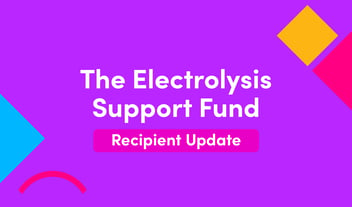Electrolysis vs. Laser Hair Removal: Which Is Right for You?

Shaving can feel like a chore for anyone, but for trans and gender-diverse folks, it can also bring up feelings of dysphoria and discomfort. For many of us, finding a hair removal method that truly aligns with our transition is a meaningful step toward feeling at home in our body, boosting confidence, and affirming our gender in a way that feels right.
ICYMI, our blog Electrolysis vs. Laser Hair Removal goes over many of the basics to hair removal services for trans folks.
 Now, let’s dive deeper into choosing the right method for you based on your skin type, goals, budget, and personal preferences. For this article, we teamed up with Danah Caudill, owner of Commonwealth Electrolysis Clinic in Lexington, Kentucky, to offer professional insights to help you make an informed decision.
Now, let’s dive deeper into choosing the right method for you based on your skin type, goals, budget, and personal preferences. For this article, we teamed up with Danah Caudill, owner of Commonwealth Electrolysis Clinic in Lexington, Kentucky, to offer professional insights to help you make an informed decision.
Reasons for Hair Removal
There are many reasons why you might want or need to remove body hair. The most common reasons for trans folks are:
- Surgical preparation: For gender-affirming surgeries such as vaginoplasty, phalloplasty, and more, permanent hair removal may be essential to prevent post-surgical complications.
- Gender expression: For many trans-femmes, body hair removal can align their appearance with their gender identity and sometimes make public life safer in certain environments.
- Managing unwanted hair growth: While testosterone has affirming effects, it also increases hair growth. For those who don’t want facial or body hair, permanent removal can help them feel more aligned with their gender identity.
Hair Removal Services
There are two commonly chosen hair removal methods for permanent results: laser and electrolysis. Each treats most areas of the body but has its own approach and effectiveness.
- Laser reduces hair growth by using laser light to target and damage the follicle. It’s a good choice for those seeking faster reduction, not necessarily removal.
- Electrolysis is considered the only truly permanent solution by the FDA. It targets each follicle with a tiny probe that destroys the follicle at the root, preventing regrowth.
Key Factors to Consider
Surgical requirements
- Laser: For those preparing for MTF bottom surgery, laser is often considered sufficient. However, it’s important to consult your surgeon for specific pre-op hair clearance guidelines based on preference and your body.
- Electrolysis: For FTM bottom surgery prep, electrolysis is typically recommended over laser since electrolysis is more permanent and decreases the likelihood of regrowth and complications.
Skin tone and hair color
- Laser: Laser hair removal works best for darker hair and light skin tones. This method relies on a contrast between hair color and skin color and has little effect on white/blonde, grey, or red hairs. Those with lighter hair or darker skin tones may not achieve their desired results with laser treatments alone.
- Electrolysis: Electrolysis is effective on all hair types and skin tones. Unlike laser, it targets the individual hair follicle and can treat hairs of any color or texture. This makes Electrolysis a reliable option for all, regardless of hair or skin type.
Body area
- Laser: Any area of the body can be treated with laser, except inside the nose and ears. Laser can cover more surface area in a single session, making it a more efficient option for larger areas. Some folks who were assigned male at birth may require additional sessions due to the effects of testosterone.
- Electrolysis: Electrolysis can treat any area of the body, but is typically more time-consuming due to treating each hair follicle at a time. This makes it ideal for smaller areas, though larger areas can be treated over multiple sessions.
Pain tolerance
- Laser: Pain levels with laser hair removal can vary a lot from person to person, depending on individual tolerance and the machine used. Many people describe the sensation as feeling like a rubber band snap against the skin. Most clinics will ask that the treatment area be clean-shaven before your session to help the laser target the base of the hair follicle effectively.
- Electrolysis: According to Danah, clients have mixed experiences with pain during electrolysis. Some find it less uncomfortable than laser, while others feel it’s a bit more intense but worth it for the permanent results. For many, the most noticeable sensation is when each hair is tweezed—about 3mm of growth is needed for the hair to be grasped. Danah tells clients to think of it as the width of a classic wedding ring and recommends letting the hair grow for 3-5 days before your appointment.
- Pain relief options: Danah suggests taking a pain reliever like ibuprofen before your session. She also recommends applying a topical lidocaine cream to the treatment area, covering it with plastic wrap up to 15 minutes beforehand for maximum relief, and letting the electrologist remove it as they go. These options are optional, and many clients choose what works best for them. Be sure to check with your electrologist ahead of time, as they may have additional tips or preferences for pain management.
Budget
Your budget plays a vital role in determining the frequency and type of treatment you can afford.
Danah emphasizes the importance of consistency when it comes to hair removal treatments. "Hair grows in cycles, and to achieve the best results, we need to target hairs in the first stage of growth, called the anagen phase, when the hair is actively growing and attached to the blood supply. With electrolysis, the goal is to target hairs in the anagen phase, as that is when they are most effectively destroyed by the treatment."
According to Danah, "Consistency is key in any treatment plan. If a client’s budget only allows them to come once a month, we stick to that plan and adjust as needed if their finances allow more frequent sessions."
- Laser: As of 2024, the average national cost of laser ranges per area. For smaller areas, the price can range from $100 - $300 per session. For larger areas, the price can increase to over $600 per session. This price varies widely and is highly dependent on the provider and the characteristics of your hair. Be sure to check in with your chosen provider, as many offer package deals that may serve your needs better.
- Electrolysis: The 2024 average national cost for electrolysis is $75 - $120 per hour. Electrolysis is usually charged on an hourly basis and is more time-consuming. The price varies, but many electrologists work independently and may offer flexibility in pricing, such as package deals or discounts. Communication with your provider is key.
The financial burdens of daily life often leave little to no room for trans folks to afford gender-affirming care. Point of Pride offers the Electrolysis Support Fund to provide financial assistance for hair removal and break down the barriers that prevent them from accessing this essential process in their transition.
Risks and side effects
Laser:
- Skin irritation, redness, and swelling
- Pigment changes (lightening or darkening), which may be temporary or permanent
- Skin burns, blistering, and scarring
- Herpes outbreak: The heat can irritate the skin and potentially activate the herpes virus
- Paradoxical Hypertrichosis (PH): Rarely, laser treatments may increase hair growth in and around treated areas. This effect is more common among individuals with darker skin tones and hair colors but can happen to anyone. Danah at Commonwealth Electrolysis Clinic has successfully treated clients with PH using electrolysis for permanent hair removal.
Electrolysis:
- Skin irritation, redness, and swelling
- Scarring and, in rare cases, infection (if tools aren’t properly sterilized)
- Lower risk of herpes activation, as electrologists are trained to avoid treating areas with active cold sores, and the electrolysis process does not trigger the virus
Alternative options and resources
If professional hair removal services are out of your budget, you may want to consider at-home laser hair removal devices. These devices, while less powerful than professional treatments, offer a more cost-effective solution and allow you to reduce hair in the comfort and privacy of your home. This method will take time to see results, but they are an excellent option for those concerned with comfort and safety.
Types of at-home hair removal devices
- Laser Devices: Use similar technology to professional lasers on a smaller scale. Popular option: Tria Hair Removal Laser x4 ($499).
- IPL (Intense Pulsed Light) Devices: Use light pulses to target melanin in hair follicles, reducing growth gradually. Popular option: Braun Silk Expert Pro 5 IPL ($429).
Though these devices are generally more affordable than salon treatments, they often cost over $400, which may still be out of reach for many. That's where Point of Pride’s Thrive Fund comes in, helping trans folks afford things like at-home hair removal devices.
Finding a trans-friendly provider
Finding a trans-competent provider for professional hair removal services, whether electrolysis or laser, is crucial to ensure you feel safe, supported, and understood during your treatments. The right provider will be knowledgeable about trans-specific needs and have experience working with gender-diverse clients.
Danah advises, "Look for someone who specializes in hair removal for transgender individuals and who is knowledgeable about the different methods available. It's important to find someone who understands the unique needs of transgender individuals and is committed to providing a welcoming, safe, and supportive environment. Check that they are experienced and credentialed, have proper training and education in their field, and are open to answering any questions or concerns you may have."
Ask potential providers about their experience with trans clients and ensure they are committed to creating a respectful and affirming space for you. For more guidance on choosing the right practitioner, you can check out our blog, Electrolysis vs. Laser Hair Removal: An Intro for Trans Folks, which goes into further detail on this topic.
If you’re unsure where to start and are looking for LGBTQ+-friendly providers, the CenterLink Directory can help you find local LGBTQ+ centers, which may recommend professionals like Danah who have made it their mission to create safe, inclusive environments for trans individuals seeking gender-affirming care.
Why This All Matters
We have witnessed how transformative access to hair removal services can be for our recipients. Many have shared stories of how it has improved their confidence and made them feel more aligned with their true selves. Here are a few quotes from our Electrolysis Support Fund recipients:
"Since beginning electrolysis, my happiness and confidence regarding my transition have steadily improved. Even just feeling the treated skin without hair texture is elating." —Annie (she/her)
"I’ve seen myself grow healthier and happier. Long term, I’ll be able to enjoy the parts of my life that I didn’t think were possible before electrolysis!" —Pierre (she/they)
"After starting hair removal I was finally able to schedule my bottom surgery, which is a part of my transition I had almost expected would never come true for me. Without exaggeration, my quality of life is the best it’s ever been." —Dolores (she/her)
No matter which hair removal method you choose—whether it’s electrolysis, laser, or even deciding not to pursue hair removal at all, know that your decision is valid. This journey is yours, and what matters most is how it aligns with your comfort, gender identity, and well-being.

Written by Point of Pride
Point of Pride provides financial aid and direct support to trans folks in need of health and wellness care.


